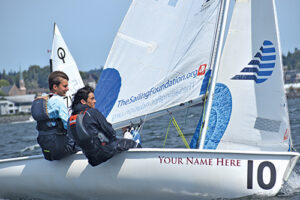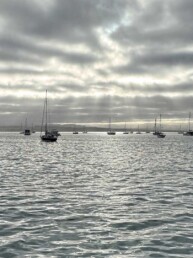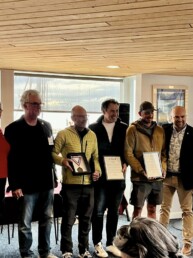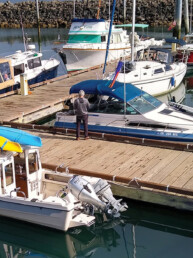In June, I came to the Pacific Northwest to be the new Youth Sailing Director at The Sailing Foundation, which has the mission to raise the level of sailing in the region. With previous experience on the US Sailing Team as well as leading junior sailing programs around the country, I am excited to be a part of youth sailing in the PNW as it continues to grow and thrive.
As a first step this summer, I went on a listening tour, visiting 17 junior sailing programs and doing my best to understand their needs and to learn more about how they operate. Throughout the six-race Northwest Youth Racing Circuit (NWYRC), I saw a lot of what makes this region great, and also identified a few concepts that would make a big difference to the performance of the sailors.
On my tour, I kept hearing, “We’re just the Northwest, we can’t compete,” but I came away impressed with the strengths of the region. One huge asset is the great deal of trust that exists between Northwest programs, and the unparalleled practice of collaboration. This results in a large number of very successful region-wide initiatives and circuits. For example, it was so wonderful to see the Corinthian Yacht Club of Seattle go to Sail Sand Point and provide the race committee for their big NWYRC regatta. Coaches collaborate and work together to solve problems like I have never seen before, even welcoming coaches from other programs to share their knowledge with their sailors. It is inspiring to see how everyone truly wants to work together to raise the level and improve the opportunities in youth sailing.
The Northwest’s geographic distance from other youth sailing hot spots has also produced some procedural isolation. Though there are things to learn from these other regions, I think this distance and isolation is a good thing. Actually, I see it as a great thing! What follows are a few of my related observations, and some of my ideas about opportunities and community action items.
THE VALUE OF SMALL, LOCAL EVENTS

Observation: In addition to the trust and collaboration between programs — and the resulting shared initiatives and circuits — There is also a strong culture of inclusiveness in the Northwest. This is obviously positive, so that we can grow our community and serve a greater population. However, it can also create some challenges for those entering the sport with little or no experience. At an event that includes everyone, it is more difficult to effectively cater to specific ages or levels of sailors. One response might be events that focus on particular groups of sailors, but another approach is to create more small, local events where varied interests and needs can take the lead.
At a club I worked for in Texas, many sailors traveled to regional events, but there were also lots of opportunities for those who were newer to sailing or preferred to sail more casually. The club hosted a few dinghy regattas during the summer, mainly for the members. The neighboring club hosted a series of events for the youth programs nearby and it was a great training opportunity for both sailors and the race committee.
Similarly, there’s a great regional circuit around San Francisco, but St. Francis Yacht Club still hosts dinghy regattas a few times a year, separate from the circuit.
Opportunity: We need more B and C level events — smaller events that don’t require participants to travel far from home. Events of this type foster an environment centered around the needs of newer sailors and allow for space for advancing intermediate sailors to compete at the front of the fleet. Additionally, the Northwest is currently running into the issue of not having enough venues that can host several hundred boats, which many of the circuit events now draw, so events with smaller fleets should also create more viable venue options. Smaller stand-alone events will also encourage more accomplished racers to try new things without it impacting the series results they’ve worked hard for.
Though the opportunity I identified is to expand the offerings for small events, some terrific ones do exist already. One way that novice racers get out in Seattle is the Milfoil Dodger series. Milfoils are great one-day events with an emphasis on fun and learning. The barrier to entry is very low and these are much simpler events to run, with the expectation of 10-30 sailors coming.
Relatedly, Corinthian Yacht Club of Seattle hosts many fantastic events that serve as vital bridges from the Milfoil series to the Northwest Youth Racing Circuit. The San Juans, Bellingham, Anacortes, and Oak Harbor have also created a circuit of high-school-style racing for local middle school sailors in RS Tera dinghies. This uses the assets in the region effectively, engages more middle school students, and is fueling new enthusiasm in the area. I am very excited to see the sailors progress as a result of this opportunity.
Community’s Next Step: Consider hosting a dinghy regatta at your local club and feel free to put an entry cap on it! Tailor the event for your members (adults and youth) and invite a few programs around you. Is your club really enjoying RS Aeros and 29ers? Have a regatta for those boats and invite people who sail other boats to try them out!
RACE COMMITTEE DEVELOPMENT

Observation: To have better and more numerous events, we need to get more people involved in race committees. The region is lucky to have a handful of very good PROs who run youth events, but presently there aren’t enough people with the desire and the know-how to facilitate the capacity for growth in youth sailing in the Northwest. We need more mentorship, race committee training, and outreach. There are lots of race committee jobs that require almost no training, and roles on the committee can be extremely varied and suit different people’s strengths, skills, and temperaments.
Limited committee resources have a direct impact on the sailing experience for the kids. We had an event this past summer where there were six fleets on the same race course. This meant that in order to adjust the race course, all racing had to come to a stop. It also kept sailors strategizing about how to dodge other fleets, instead of thinking about what a wind shift might do. A more robust committee could have separated the fleets onto two race courses and helped the sailors have a more rewarding time on the water.
Opportunity: On top of being great for the sailors, adding B and C level events would create opportunities for race committee training and add experienced people to the race committee community, reducing the burden on the handful of more experienced folks who are currently very active. This bigger pool of volunteers would also allow us to do a better job of running the events with up to 200 boats.
Community’s Next Step: Reach out to your local sailing organizations and ask how to become involved in race committee. Go to the US Sailing website and read about the roles on the race committee team, and consider what appeals to you. Ask your club to host more race committee training sessions. Are you a race committee member already? Invite a friend to join you!
NORTHWEST YOUTH RACING CIRCUIT

Observation: Another regional strength is the Northwest Youth Racing Circuit (NWYRC). This circuit of roughly six events in great venues attracts programs from all over the Northwest. The fleet is tight, so sailors are pushing each other to get better. From what I’ve seen around the country, most regattas and circuits die because the fleet is too spread out; it’s no fun to be in a dinghy and not see your friends smiling as you cross each other back and forth. In the Northwest, there is a big range of abilities, but everyone seems to find a group of sailors at their level that they are racing against.
Opportunity: This network creates a great training tour for our sailors to experience traveling for events, different venues and conditions, and strong competition. This series requires a great deal of planning and support; and as the events continue to grow, the demands for support increase.
Community’s Next Step: Volunteer! Race committee is a great place to start, but there’s also support in planning meals, assisting with housing, and various other shoreside projects. Let your skills and strength shine. A parent volunteer came on the race committee finish boat for the first time this summer and saved the regatta because she was so good at reading/hearing sail numbers finish in rapid succession and writing them down. Without her, I believe we would have had to scrap one race, which would have been heartbreaking. The good news is that so many of these volunteer opportunities are as fun as they are rewarding. There’s no limit to how the circuit can continue to grow and improve with increased volunteer support.
GEOGRAPHIC DISTANCE AND PROCEDURAL ISOLATION
Observation: There are the obvious challenges that come with being less connected (in all the ways) with the sailing activity in other regions of the country — from limited exposure to what the rest of the country has figured out, to not getting recognition for the region’s triumphs by having our sailors on display at many competitions nationally. It also can make it more difficult to draw in outside coaches. However, what might be seen as the Northwest’s greatest weakness is also the region’s greatest strength, because the region has not been exposed to bad practices cropping up around the country.
One example is the way the junior sailing scene around the U.S. has shifted toward a “pay-to-play” landscape for sailors as young as 9 years old. Other nations have well-funded National Governing Bodies (NGBs) that tend to be tied to Olympic team development. These NGBs enable the execution of long-term strategies and create pathways that are relatively affordable for talented and dedicated sailors. The U.S. does not have an NGB that is financially supporting a unified and cohesive pathway and, in this vacuum, some coaches are seeing a lucrative business opportunity. Coaches are coming in and creating travel teams independent of yacht clubs. While some families find youth sailing to be expensive already, without club and community support, the cost to sail with these teams is even higher — effectively leading to a pay-to-play environment. This is troubling for many reasons: it creates a financial barrier to information, and leads to a sailing equivalent of a “brain drain” from local programs. Sailors who are driven and can afford to participate in a travel team are leaving their home programs, reducing support for those programs and leaving the sailors in the home programs without consistent exposure to this group of often more accomplished sailors. Travel team sailors seldom return to coach the next generation, and thus these programs miss out on the inspiration of seeing friends become great coaches too.
Since the Northwest is largely isolated from the phenomenon, boasts the community strengths of trust and collaboration, and has strong leadership organizations, we are well positioned to initiate plans and pathways that reflect philosophies that have been successful in other nations.

Opportunity: In Norway, their model mandates that athletes stay local in order to build strong foundations and to create a bigger pool of good athletes. In this environment, athletes wait to specialize in a chosen pursuit until they are between 17 to 27 years old, and thus peak at the correct time; also helping young enthusiasts avoid burnout.
The British model has sailors stay with their local programs their entire junior career and when the junior sailors are recognized as having potential, national coaches come to the region and run clinics for these top sailors and their local fleets. At a certain level, the most talented sailors travel as a team outside of the region for competitions, but they always practice with their home programs. Keeping the talent local and the cost low, sailors are not priced out or asked to essentially become full-time travel athletes.
Models like these mean that sailing skills and enjoyment increase locally, but it also means that the talent pool of skilled athletes is larger when it comes time for sailors to compete for senior world titles. The Northwest has a number of individuals, clubs, and organizations currently working towards systems that provide the best experience for young sailors and raise the level of sailing throughout the region, and these efforts are supported by the US Sailing Olympic Development Program.
Community’s Next Step: Think about ways that you can support and enable a fun and rewarding local sailing environment for young people, and then take action. Help youth sailors develop a diverse love of sailing. Invite kids and their families to sail on your boat; volunteer at youth events; create a fun, casual dinghy regatta for your local community; or consider donating to the organizations endeavoring to grow and support youth sailing. Candidly, neither The Sailing Foundation nor any other Northwest entity can provide funding like international NGBs do. The Foundation does not have the legal control, but it is well positioned to put these proven philosophies in motion because of all the great things happening in the Pacific Northwest for sailors.
All these strengths lead me to believe there is a strong future ahead for youth sailing in the Northwest. I’m still new to the region, but I think there is lots we can achieve together.
Solvig Sayre is the newly hired Youth Sailing Director at The Sailing Foundation, where she works with programs around the Pacific Northwest. She has extensive experience on the US Sailing Team and leading youth programs around the country. Check www.nwyouthsailing.org.
Feature photo by Maddy Lindburg.






